How often is it ok to send email campaigns for your online store?

As a newsletter sending provider, we get a lot of email marketing questions. But if there’s one question that comes up more often, it’s about the optimal frequency of sending email campaigns to subscribers.
It’s only natural to be concerned about the sending strategy. If you send too many emails, people start to get annoyed, mark them as spam and unsubscribe. And on the other hand, if you send too few emails, the subscribers in your list are no longer kept informed, forget about your brand and become inactive. Reactivating or re-engaging the inactive is not an easy road, and if other brands are getting them used to an acceptable regular flow, then you who don’t really let them know appear a bit unreliable, not inspiring trust, in addition to others who have a well-established, regular campaign schedule.
So what’s the solution? How often is it ok to send email campaigns so that you don’t fall into either camp?
Email campaign frequency statistics
Thinking about identifying the right frequency to send newsletters, we decided to do an internal study on online shops’ mailings to their subscribers. Most of the merchants are in the small and medium business category, so the resulting data will provide useful insight to all SME eCommerce businesses promoting their business through email marketing campaigns.
In order to have the most accurate results, we only considered bulk email campaigns and excluded from the analysis any automated campaigns such as welcome or order confirmation campaigns. Here are the results:
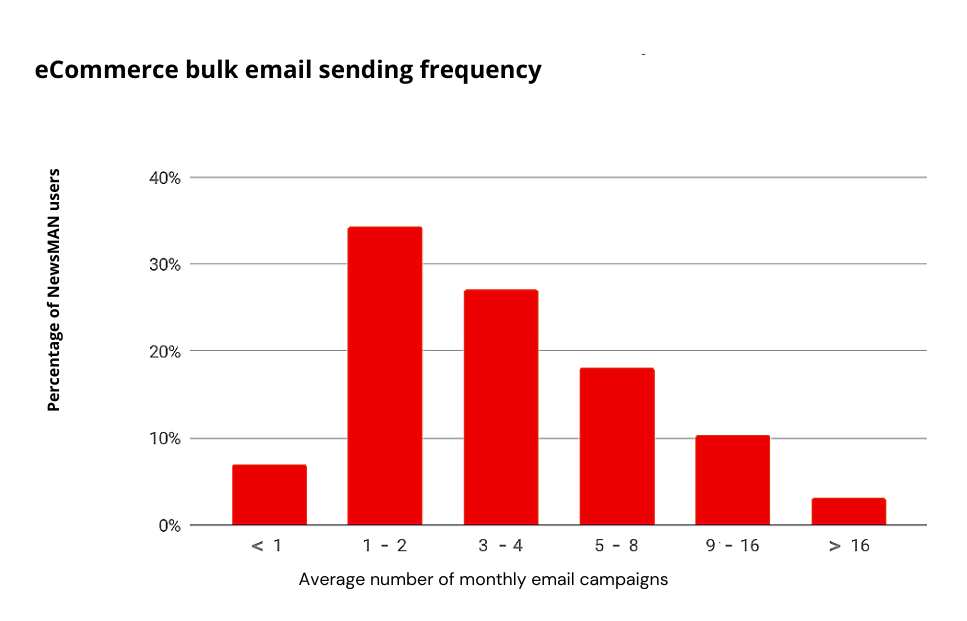
It seems that most online shops send about 1-4 newsletters per month to all subscribers, which is about 1 email per week.
One in five merchants send between 5 and 8 bulk newsletters per month, or 1 – 2 per week.
And only a small percentage (2.5% of the total) send more than 16 emails per month, or at least one email every 2 days.
If we draw the line and take everything into account, we find that most of the online shops surveyed keep a decent frequency of sending email campaigns to subscribers, so that customers don’t get hooked by too many messages.
And yet two questions arise: Is it right for marketers to be so cautious or not? Do those who send more often to customers get better results than the rest who refrain?
How often should you send email marketing campaigns?
Now that we’ve seen how often online stores send email campaigns to subscribers, it’s time to see how exactly customers respond to those frequencies. By analyzing this, we can determine what are the best practices regarding the frequency of email marketing campaigns.
Open Rate bulk email campaigns
Comparing the average number of bulk email campaigns sent per month with the resulting open rates, we get the following statistic:
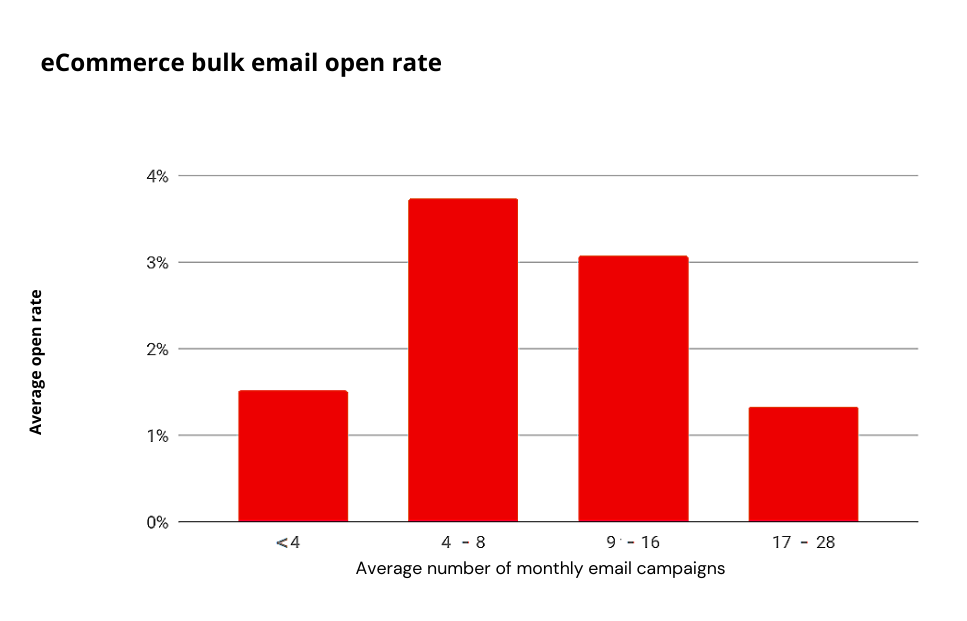
From the graph above, we conclude that online shops that send 4-8 email campaigns per month to all subscribers in their list, get the best open rate results.
Those who send between 9 and 16 newsletters achieve a similar open rate to those who send up to 4 campaigns per month.
Open rates progressively decrease as you start sending more than 1 email every 2 days. This is clear evidence that subscribers don’t want to receive daily emails from you.
Click rates of bulk email campaigns
Let’s also take a look at click rates. It seems to change the story a bit.
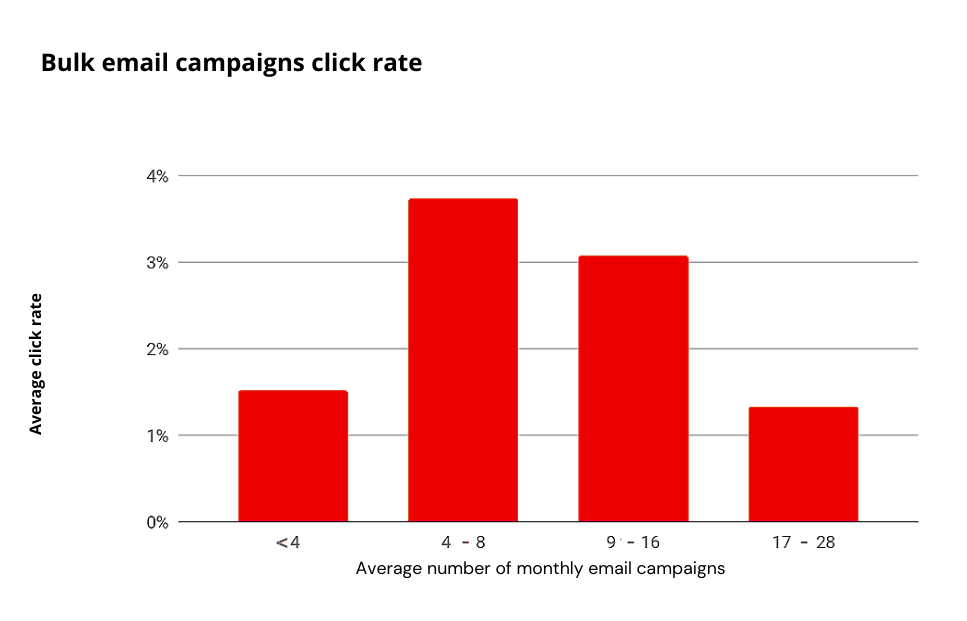
It seems that just like in the previous open rate graph, the frequency of 4 – 8 monthly campaigns wins in click rates as well.
The too frequent email campaigns of 17 – 28 emails per month, however, perform just as poorly as the less frequent < 4 per month.
This highlights the need to keep list subscribers engaged with a regularly sent newsletter. On the one hand. if you send less than 4 emails per month, you run the risk of low interest in the content you send and no clicks on the site. And on the other hand, the risk of sending too often is clearly reaffirmed. If you send an email every 2 days or more, your engagement rate drops massively.
Sales following eCommerce email marketing campaigns
Open and click-through rates are great for seeing people’s interest, but in eCommerce email marketing campaigns all that matters is the sale. Which makes the sale the most important metric.
Let’s measure and take a look at how many clicked and completed with purchase after receiving email campaigns. Do sales decrease or increase if you send more newsletters? Let’s see what the numbers say:
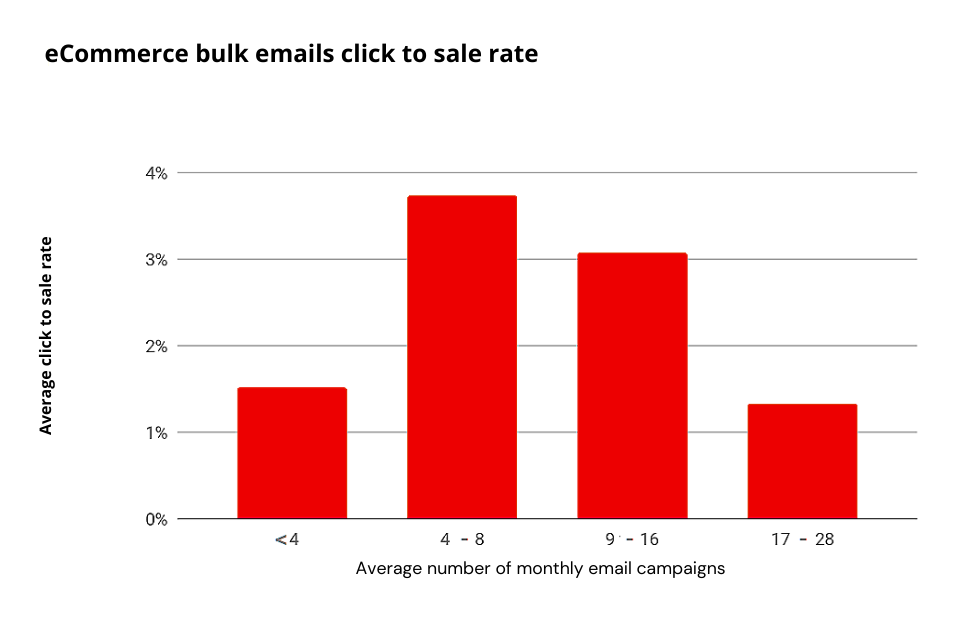
If we look at how the average number of email campaigns sent per month affects the number of sales a marketer receives, we see an interesting pattern.
The percentage of clicks resulting in a sale seems to follow a downward trend. The more often you send email marketing campaigns, the more clicks it takes to generate a sale.
At first glance it seems that even the weekly newsletter is too much. But let’s take a closer look at the results.
Customers like to feast their eyes on favourite or new items in the online shop, spend as much time as they want and buy if they see fit. However, they reach a point, a limit where they won’t buy no matter how much you encourage them to do so.
In the end everyone has their financial limit, which takes into account other planning and no matter how many commercial newsletters you send them, they will not cross that limit.
The question is: how many emails do you send them before they reach the limit?
If the limit has been reached at 1 email per week, then by default you expect sales to drop by 50% if you send campaigns 4 – 8 times per month. So you end up sending twice as many emails as usual, but sales don’t increase.
However, the graph above does not show this. The reduction in sales is small, suggesting that sending more than 1 email per week has a slightly positive effect on sales. In other words, sending 2 emails per week increases sales, but does not double them as with a single newsletter.
The effect of decreasing profit is observed. Each additional email you send has worse sales results than the one before it. So we quickly come to the conclusion that high frequency of sending email campaigns does not bring more sales at all and more than that it can even hurt. People will reach saturation, become irritated and unsubscribe, which means you lose future potential purchases.
How many email campaigns are too many?
So what do all these statistics mean? How many emails are too many? It seems that 1-2 newsletters per week is an appropriate frequency.
Ultimately, the optimal frequency of sending email campaigns will depend on the respective online shop and its subscribers, but the result from the statistics is a good starting point.
If in addition to the optimal frequency, you send an extra email a week every now and then, it’s not a big deal. But if it becomes a frequent habit, subscribers besieged by the avalanche of emails will unsubscribe. And this affects your customer lifetime value. Remember that the #1 reason for unsubscribing is receiving too many emails (according to a Marketingsherpa study).
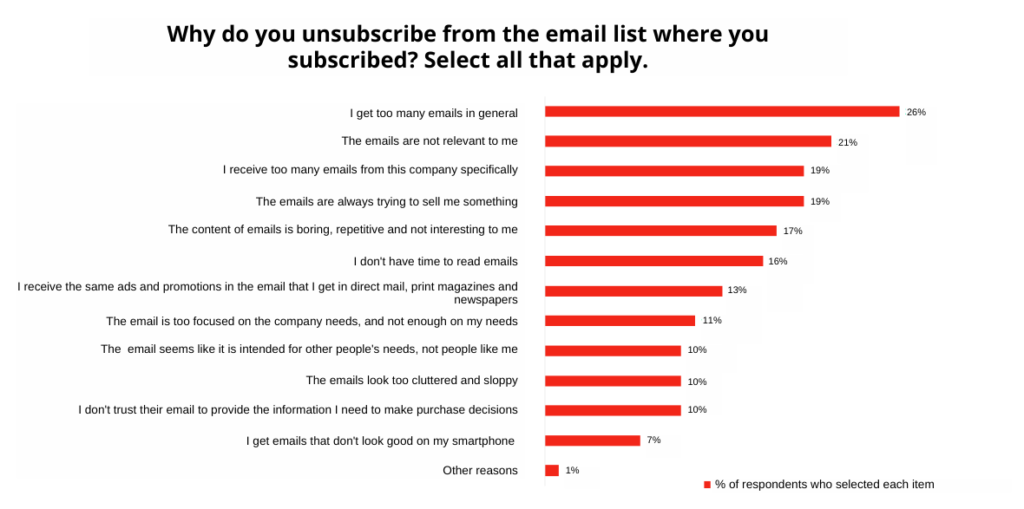
And if they don’t unsubscribe instantly when they get too many emails, they’re doing something else that affects your deliverability. They either mark them as spam or delete them outright without reading them. And then, email clients like Gmail or Outlook move them directly to Spam in both cases for whatever user will be emailing you in the future.
Best practice sending frequency email campaigns
Let’s summarize all the information obtained to see what are the best practices on the optimal sending frequency of email marketing campaigns resulting from the study of newsletter senders in the SME eCommerce sector. Here are the findings:
- Sending at least 1 newsletter per week to all subscribers helps you not to lose contact with subscribers and sales opportunities. Otherwise, they will forget about your brand if they don’t receive relevant news and therefore miss out on potential orders.
- Sending 1-2 newsletters per week. This is ideal for most online shops, especially if they are just starting out with email marketing.
- Sending 1 newsletter every 2 days or more will drastically decrease subscriber engagement without generating more sales.
Of course, every online store is unique. If you want to find out the optimal frequency for your online store, you should also consider other important factors such as average purchase frequency and average time between purchases.
You can find the average purchase frequency by dividing the total orders by the total unique customers in a year. And the average time between purchases is calculated by dividing 365 days by the average purchase frequency.
For example, you have 5000 orders per year and 400 unique customers. The average purchase frequency is 12.5 per year. And the average time between purchases is 29.2. So on average each customer buys once every 29 days. Let’s see how often you should send them your newsletter.
I also pulled the stats for weekly mailings and time between purchases to find out what the average frequency is for most small and medium-sized online stores that use NewsMAN.
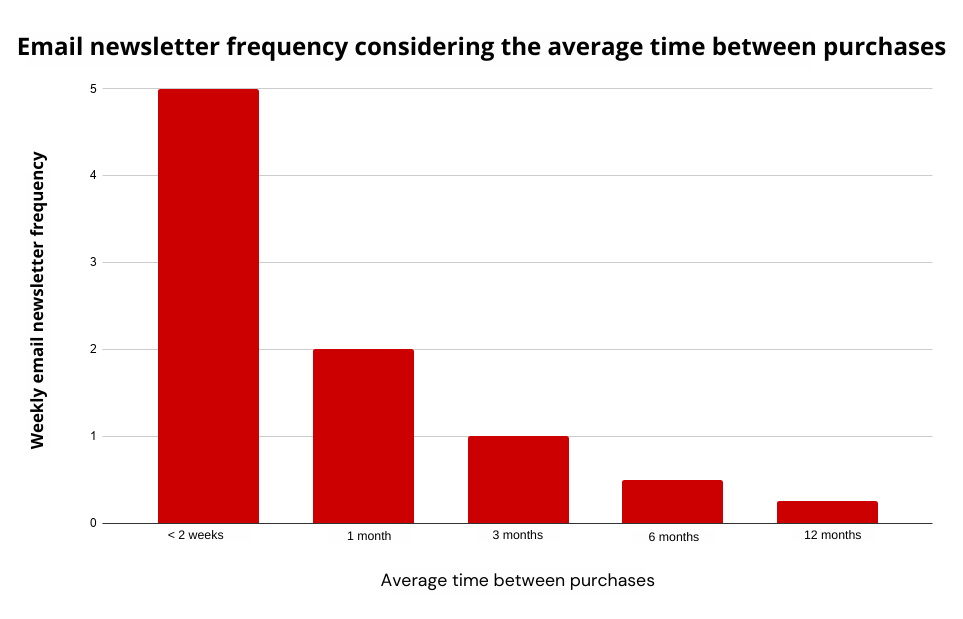
So, referring to the example above, if the average time between orders is 29.2 days then you can send them a maximum of 2 newsletters per week.
If you send a series of automated welcome emails after sign-up, wait for the series to finish, then you can send campaigns without triggering.
Of those maximum 2 newsletters per week one can be informational and the other commercial. Don’t forget that 19% unsubscribe because they receive too much commercial content (see statistics in the How many campaigns is too many? section)
Extra recommendations, newsletter referrals:
1. Take into account statistics, your own figures and in addition use the best newsletter sending time. If you tick this option in your email marketing platform, you will notice an improvement in results.
2. Whatever you send whether it’s personalized, commercial, or useful informational content, try to emphasize the value it brings to your audience.
3. Give subscribers the ability to choose their own frequency and topics of interest through a customised subscription form.
We hope the information in this article has been useful and will help you send email campaigns that get results. Good luck with conversions and happy customers!